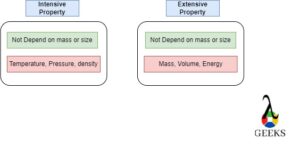The properties of matters divided into two-part, either it is an intensive or extensive property. List of intensive property examples
- Density of the substance (ρ)
- Temperature (T)
- Pressure (P)
- Viscosity (μ)
- Electrical conductivity
- Specific volume (v)
- Specific heat capacity (Cp)
- Specific weight (w)
- Specific Internal energy (u)
- Color
- Odor
- Luster
- Boiling point
- Melting Point
- Hardness
- Ductility
- Malleability
- Surface tension (σ)
- Refractive index
- Molality (m)
- Concentration (c)
- Thermal conductivity (k)
- Magnetic permeability (μ)
The properties of the matters are divided into two parts broadly. We are going to explore on intensive property examples.
An Intensive property is one whose extent does not depend on the system’s mass or matter. In other words, we can say that the size of system does not play any role in the intensive properties.
It does not matter whatever amount of material is present in the system. An intensive property is the same even if the material is 1 kg or 1000 kg. The intensive properties in the material vary from point to point as per the situation.
Temperature
For example, if we measure temperature or pressure at one end of a pipe (300 K, 1 Bar). It is possible that the other end data may be different (325 K, 1.5 Bar).
Pressure
The temperature or pressure does not depend on how much quantity, but it depends on which point we are measuring.
An extensive property is related with the size of the system and the mass of the system. It varies if we change the system’s size or mass.
There is a straightforward way to differentiate between intensive and extensive properties.
- Step 1
- Take a sample with appropriate mass and size.
- Step 2
- Now break the sample into two pieces. Two-piece of sample: A, B
- Step 3
- Now measure particular properties like temperature volume and observe
- Step 4
- If a property is the same for both pieces, It is an intensive property—for Intensive property examples, Pressure, Temperature, density, etc.
If a property is different for both pieces A and B, It is an extensive property. For example: Mass, Volume, etc.
The intensive property examples is the same for small samples and bulk systems. It is most helpful for the sampling process. The property of a small sample is the same as the property of a large system. It is useful in many fields of engineering and science.
Sometimes questions arise in our mind that density is the ratio of the mass and the volume. Still, the density is the intensive property. What is the reason behind it?

Density
In actuality, The mass and the volume both are extensive properties. The ratio of the two extensive properties turned into an intensive property examples. That’s why density is the intensive property examples. Now one question to ignite your mind, Why is density displayed on the fuel pumps? If you have answered the, write it in the comment section.
Specific Properties
One more hint: The specific properties are always intensive—the specific properties like specific volume, specific weight, specific heat capacity, specific internal energy, etc.
Color | Odor | Luster
The properties like odor, color, and luster are tested while examining samples. These properties are not related with the mass or size, so it’s intensive.
Intensive properties are bulk properties, which means they do not depend on the amount of matter present. Examples of intensive properties include:
Intensive property examples can help identify a sample because these characteristics do not depend on the amount of sample, nor do they change according to conditions.
Boiling Point| Melting Point
The temperature is the measured on individual point, so the boiling and melting point are also intensive. The boiling point is the measured value of temp. (on liquid start evaporating). The melting point is the measured value of temperature (on solid start melting). The pressure and temperature are related with the particular point.
Material Property
The properties of material like ductility, malleability, and hardness do not depend on the object’s size or mass. These are an intensive property examples of material science and metallurgy. In every engineering field and science, the intensive properties are studied at a significant or certain level.
Viscosity | Surface Tension
In fluid mechanics, Two widely known terms are surface tension and viscosity. These both are considered intensive properties. The dynamic viscosity is a fundamental property to measure samples of oil, fuel, and chemicals. It can vary with temperature, but it does not change with fluid mass. The surface tension is the phenomena of opposing the tensile force developed on the liquid surface. Because of surface tension, The bird can drink water.
Electrical Conductivity
The electrical conductivity is related on the No. of valences to pass electric current. The material’s thermal conductivity is more if the material can transfer more heat. It depends on the free electrons. No mass or size interaction comes into the picture.
One popular technique for one to remember the definition of the intensive property,
Intensive means “Independent on mass or size“. Recall the word “In”. It is straightforward to remember.
Opposite to intensive is the extensive property.

I am Deepak Kumar Jani, Pursuing PhD in Mechanical- Renewable energy. I have five years of teaching and two-year research experience. My subject area of interest are thermal engineering, automobile engineering, Mechanical measurement, Engineering Drawing, Fluid mechanics etc. I have filed a patent on “Hybridization of green energy for power production”. I have published 17 research papers and two books.
I am glad to be part of Lambdageeks and would like to present some of my expertise in a simplistic way with the readers.
Apart from academics and research, I like wandering in nature, capturing nature and creating awareness about nature among people.
Also refer my You-tube Channel regarding “Invitation from Nature”